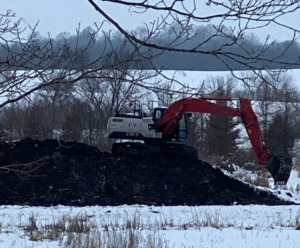 By Peter Ziegler, WWA Project Director
By Peter Ziegler, WWA Project Director
WWA continues to put habitat on the ground through the winter. We recently started a project in central Wisconsin that will plug four ditches and flood a couple scrapes, while creating wet prairie/sedge meadow habitat surrounding the area. With some established nesting habitat adjacent to the scrapes, this certainly should produce waterfowl.
WWA also finished up a project in Dodge County last month which created a variety of moist soil units. These will be managed for annual seed production, providing good migratory stopover habitat. The importance of these types of wetlands is that they provide high-density and high-value energy for waterfowl when they most need it.
I will be changing gears as the snow starts to melt and I can get into the wetlands and accurately survey and assess them for restoration potential. I have a couple projects that need a survey, and others that need planning permitting work. We will continue to move forward with projects so we can get them on the ground come summer and drier conditions.
As a representative for WWA on the review committee for the Wisconsin Habitat Partnership Fund last week, I participated in the review of grant requests. This funding opportunity was provided by WDNR and is meant to allocate the funds they received from the Pittman Robertson Fund at the state level. Of note relating to waterfowl, is work to control phragmites and cattail at Rush Lake. This should help open up areas that will hopefully provide better, and more, opportunities for waterfowl hunters.
Also approved was work on Lake Butte des Morts, which will restore emergent wetland habitat. This area (Winnebago Lakes System) historically was excellent waterfowling, but the loss of emergent vegetation for food and cover has greatly reduced its importance. At one time, a significant portion of the eastern continental canvasbacks used these lakes during migration, but have now shifted to the Upper Mississippi River. This goes to show how the loss of habitat can greatly impact how wildlife and waterfowl, specifically in this case, do or do not use particular bodies of water.

